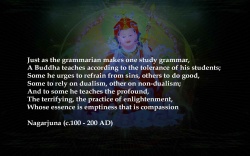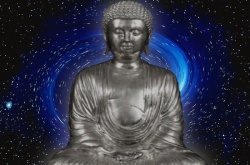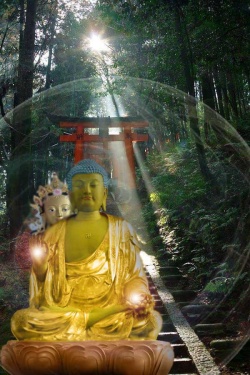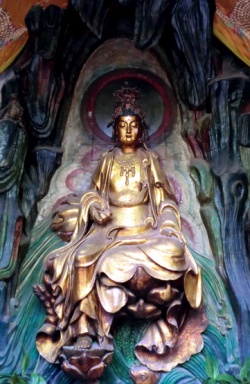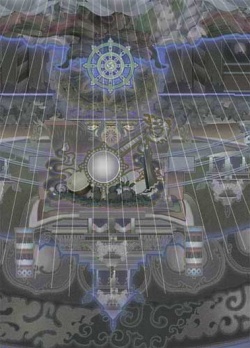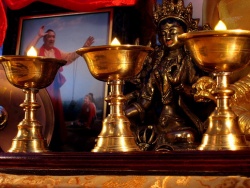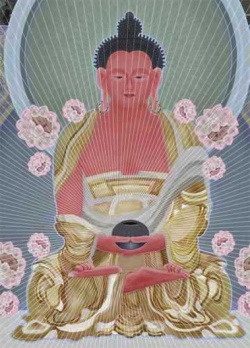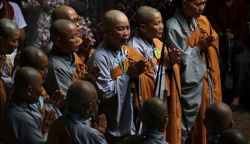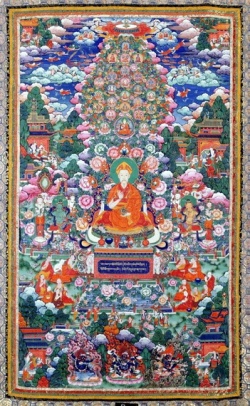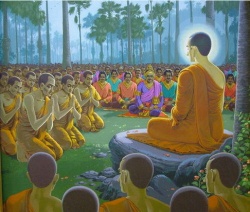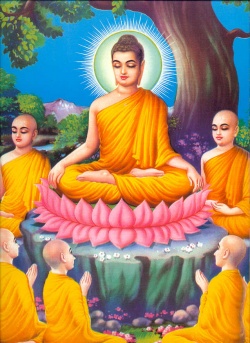Manual of Pramana - Reading One: Why Study the Art of Reasoning?
Selection from the collected topics:
Why study the art of reasoning?
The first two selections here are from a monastic textbook entitled An Explanation of the Science of Logic, included in the Advanced Path of Reasoning, a Section fromthe “Key to the Logic Machine”—a Presentation of the Collected Topics which Clarifies the Meaning of the Great Scriptures on Valid Perception (Tsadma’i gzhung-don ‘byed-pa’i bsdus-grva’i rnam-par bshad-pa rigs-lam ‘phrul gyi lde’umig las rigs-lam che-ba rtags-rigs kyi skor). This text was written by Purbuchok Jampa Tsultrim Gyatso (1825-1901), who in his day held the position of Tutor to the Dalai Lama.
Between the two sections is a very relevant snippet from the Overview of the Perfection of Wisdom, composed by the great writer of textbooks for Sera Mey Tibetan Monastery named Kedrup Tenpa Dargye (1493-1568).
Our first selection discusses the importance of learning how to reason well:
I bow down to my Lama and my Protector, the glorious Gentle Voice
(Manjushri).
Here begins An Explanation of the Science of Logic, included in the Advanced Path of Reasoning, a Section from the “Key to the Logic Machine,” a Presentation of the Collected Topics which opens the door to the art of reasoning.
Let us consider first the quotation [fromMaster Dharmakirti's Commentary on Valid Perception) which says:
I bow down to the Teacher, the One Who has Gone to Bliss,
To the Protector, the one who is totally correct,
Who undertakes to benefit every living being.
The purpose of these lines is to show that our Teacher is a teacher who is totally correct (Tib: tsad-ma; Skt: pramana), and a teacher who is infinitely superior to those of non-Buddhist traditions. The reason here is that he “undertakes to benefit every living being”; which is to say, he was created by a very special cause—consummate thoughts and actions.
“Just what,” one may ask, “are the extraordinary qualities which our own Teacher possesses?” This is answered in the words “the One Who has Gone to Bliss, the Protector.” Our Teacher possesses both a consummate form of all that will benefit himself—that is, he has eliminated every negative thing within himself; and he possesses as well a consummate form of all that will benefit others—which is to say, he has realized all knowable things. As such he is said to be a Protector surpassed by none other; for as the Commentary [on Valid perception) says, “He has smashed the web of ideas, and…”
And so it is that our Teacher is a teacher who is totally correct; and that his teaching is a teaching which is totally pure; and that the correct perceptions described in his words—that is, the pair of direct and deductive perception—are totally pure and correct methods of perception for us to use. The causes that create the Buddha are consummate thoughts and actions. Proving that these constitute a totally pure path that we should practice is accomplished by using the eight different forms of logic. As such there is but one main way of keeping the teachings of the victorious Buddha safe in the world, and this is to become a master of the logical forms used to prove some things and to disprove others. As the Goldmine of Reasoning [by the Sakya Pandita, Kunga Gyeltsen (1182-1251)] says,
Suppose a person comes to understand
The scriptural tradition for how to reason:
This art of proving or disproving things.
A master like this is a person who keeps
The teachings of the totally enlightened
Buddhas safe here in the world.
The role of faith versus the understanding that is born from the ability to reason properly is stated clearly in many scriptures on the perfection of wisdom, including the following:
Here our discussion will have two parts: a description of the different ways in which people gain feelings of admiration for the Mother [of the Buddhas—that is, the perfection of wisdom) along with a discussion of the need to reach this emotion; and an explanation of what it means when we say that developing the three kinds of high knowledge—foundation knowledge, path knowledge, and omniscience—has no true existence.
Here is the first of the two. Suppose someone makes the following claim:
Consider the section where the commentary makes this statement: “At this particular point at least, those who follow after faith develop, quite quickly, strong feelings of admiration for it, beyond all doubt.” There is a certain kind of disciple being referred to directly here, and that is the one who is studying the Ornament [of Realizations by Maitreya) and who is poor in his intellectual capacity—the kind that follows a teaching because of his or her faith alone. It is this kind of disciple for whom the
Ornament was designed.
But you are wrong in your assertion. It is always the case that, if a person is one of those disciples for whomthe Ornament was designed, then he or she is a person who belongs to the greater way, and who possesses intellectual abilities which are extremely high. Think about these people—the ones who belong to the greater way and who possess an intellect which is very great. They don’t begin to feel admiration for the three kinds of high knowledge simply based on the fact that someone has described to them the extraordinary qualities that these three possess. Rather they use correct forms of reasoning to come to a clear understanding of what the three—that is, foundation knowledge, path knowledge, and omniscience—really are, and they do the same to establish in their own minds the fact that neither people nor their “things” [or parts] have any nature of their own. When they have in this way come to actually see things through a valid form of perception, then they begin to have feelings of admiration for the Mother, for the three types of high knowledge—it is only then that they begin to have the kind of faith which believes in the good qualities of its object.
The second selection is a very famous quotation from scripture which is memorized by every young monk who begins the geshe course in a Tibetan monastery. It describes one of the ultimate reasons for studying the art of reasoning:
There is a sutra where it says,
No person should ever judge another; those who try will fall.
The point of these words is to show us how wrong it is for us to say that someone else lacks any particular good quality, only because it does not appear to us that they do. This same point is made in the Commentary with lines such as the following:
In a case where valid perception has yet
To engage in the object, the result obtained
Is that they don’t: they didn’t engage.
The full story behind this quotation is not often told in traditional Tibetan monasteries. It appears as an important section of the Greater Compendium of All the Sutras (Mahasutrasamuccaya, mDo kun las btus-pa chen-po), compiled by Lord Atisha (982-1052), and is translated here in full:
(Lord Buddha is speaking to his disciples, and describing a Buddha who had come before him:]
“The holy Dharma survived in the world for a thousand years after this Buddha, the One Gone Thus, had passed into his final nirvana. After that, those special sounds that came from the trees and spoke the Dharma to people disappeared as well.
“Listen, o child of noble family. That Buddha—the One Gone Thus, the Destroyer of the Foe, the Totally Enlightened One whose name was ‘Towering like the Mountain at the Center of the World’—passed into his final nirvana only after he had appointed a certain monk, a teacher of the Dharma by the name of ‘Pure Life,’ to protect the teachings in this world.
“In those days there came another monk, one whose name was ‘Intellect of Action.’ He was possessed of a veritable mountain of morality, and had as well attained the five different kinds of worldly clairvoyance. He was moreover well versed in the scriptural collection concerning the subject of vowed morality.
“This monk lived with a group of followers who were the highest masters of an ascetic way of life, and who had found joy in living with nothing but the worst of food and lodging. They all built themselves an abbey in which to stay, and there Intellect succeeded in bringing his followers to a very high and pure level of moral living. They came to have a deep love for the way of vows, for the way of life that leads of purification.
“This monk, Intellect, spent his days making great efforts in the spiritual life, and in his heart he kept to the Wish for enlightenment. He was continually urging all the other aspiring bodhisattvas to live this way of life as well, and to keep up a worldview, a way of looking at things, which was pure and correct.
“He succeeded in bringing the others to believe in that part of the view which states that all things with causes are impermanent. He succeeded in bringing themto believe that all things with causes are suffering. He succeeded in bringing themto believe that nothing with a cause has any nature of its own. He became a great master of single-pointed meditation. He became a great master of the deeds of a bodhisattva, and he came to possess a great store of good karma within him.
[Our reading here reverses the negative particle ma in the Tibetan, which seems to be a printing error, given the context.]
“Now that other monk named ‘Pure Life,’ the teacher of the Dharma, came to be a great master in being able to understand the needs of other living beings, whether they were of the very highest or the very lowest of intellectual capacity. He and every one of his followers reached a point of true fluency in the way of life which leads to purification: they became well versed in the meaning of the invisible [that is, emptiness), and learned as well the art of acting in unexpected ways to help others.
“Listen, o child of noble family. There came a day when the teacher, Pure Life, came with his followers to the abbey where the monk Intellect was staying. They took up residence there. Pure Life, out of compassion for those living in the nearby towns, would often leave the abbey and go to take his food with the people. Then he would return home to the abbey. There in the homes of the people he was able to bring many hundreds, nay—many thousands, of families to have faith in the Dharma.
“All of Pure Life’s followers came to be masters too in this way of helping others. They would also go to the towns, and teach the Dharma to the beings who lived there. They too brought many hundreds, nay—many thousands, of living creatures to the unsurpassed state of a purely and totally enlightened being.
“All the followers of the monk Intellect devoted themselves to meditating, and never went into the towns. There came a time when the monk Intellect began to lose his faith in those other bodhisattvas. He began to talk about how they were always going into the towns, and finally ordered that the gandi stick be beaten, to announce an assembly of the community of monks. When they had all come together, he gave the following order:
” ‘None of us is allowed to go to the towns any more,’ he said. ‘You are behaving carelessly. And what need is there anyway for those who are supposed to speak little to go to town? Staying in the monastery is an activity which Lord Buddha has clearly allowed us, and which He has recommended for our way of life.
“And so did he command them: ‘You must stop going into the towns now. Spend your days here, wrapped in the pleasure of meditation.’
“Listen, o child of noble family. Pure Life and his followers refused to follow the order, and continued to go frequently into the towns. Once, when they had returned to the abbey, the monk Intellect again had the gandi stick beaten, calling an assembly of the monks. There in the assembly, Intellect made the following declaration: ‘Fromnow on, anyone who goes to town is prohibited fromstaying in our abbey.’
“Listen, o child of noble family. The monk Pure Life—this teacher of the Dharma—determined that he would try to protect Intellect from wrong thoughts, and so he called together all his followers, and said to them, ‘Now none of you should go to town.’
“But then came a problem with all the people whom these monks had sought to develop spiritually. Because they no longer had any contact with the monks, these people began to be very upset, and a dark cloud began to form over all the good karma they had collected up to that time.
“Listen, o child of noble family. Three months passed this way, and then the monk, that teacher of the Dharma, Pure Life, moved away from this abbey and went to live in another. From there he would go to the towns, and to the cities, and to whole areas and other lands, and so too among those who lived in the palaces of kings, and taught the Dharma to the people.
“Listen, o child of noble family. The monk Intellect saw the teacher of the Dharma, Pure Life, going out all the time. He also saw this teacher’s followers acting in ways that seemed worldly to him, and he began to lose faith in them as well. And then he began to criticize the monk widely, in the following words: ‘This monk has lost his morality; he is corrupt. How could he ever achieve enlightenment this way? He goes further and further from enlightenment. There he is, living in the hustle and bustle of the everyday world.’
“Listen, o child of noble family. Later on there came a day when this monk named Intellect breathed his last. As soon as he died, the karma of his actions ripened, and he dropped to the hell we know as ‘No Respite.’
“Intellect remained in this great hell, experiencing each of its torments, for 99 periods that each went on for a hundred billion periods of ten million eons each. Then he spent sixty lives constantly slandered by others. And for 32,000 lifetimes he was a monk who lost his robes.
“When all these karmic obstacles had befallen him, there was some karma still remaining. These led him to a birth in the days when the Destroyer of the Foe, the Totally Enlightened One, the Buddha named Immaculate Shining Light, was teaching in the world, and he took ordination in His way. He made incredible efforts, exerting himself with the same effort that a person would if his hair had caught on fire, for sixty thousand periods each made of a hundred periods of ten million years each. And yet he was unable to reach even the level known as ‘mastery,’ which leads into the realization of selflessness. He spent many hundreds and thousands of lifetimes as a person with the dullest of intellect.
“Listen, o child of noble family. You may think that the one monk, the teacher of the Dharma, the one named Pure Life in those days, was just any person at all. But don’t think that way. Why do I say this? Because it is the One Gone Thus, the Buddha whomwe know as Unshakable, who was in those days that monk, the teacher of the Dharma, by the name of Pure Life.
“Listen, o child of noble family. You may think that the other monk, the one named Intellect, also a teacher of the Dharma, was just any person at all. But don’t think that way. Why do I say this? Because it is I myself who was that teacher, the one named Intellect. And it was I who—due to some small incident—came to lose my faith. It was I who created the karmic obstacle. And it was I who, because of it, fell down to hell.
“Listen to me, o child of noble family. Speaking in a way that will split up other people is a great karmic obstacle. Listen, o my child. Anyone who wants to avoid this obstacle must never feel anger about what others may do. They must trust in all that others do. They must think to themselves, ‘I cannot know what this other person is really thinking. It is a difficult thing to understand all that others do.’ They must come to develop this way of thinking.
And because He had grasped this king of all ideas, the One Gone Thus then spoke the following, and thus taught the holy Dharma:
No person should ever judge another. Those who do try to judge another will only hurt themselves. Only I, or someone like me, is able to judge another.
“Listen, o child of noble family. Those who wish themselves well should never spend their time examining what anyone else at all is doing. They should never criticize another, saying ‘Those people are doing this and that. This person is doing such and such.’ Rather they should spend all their day, and all their night, in trying to practice the teachings of the Buddha.
“Listen, o child of noble family. A bodhisattva should never spend his time working to criticize others, for he or she must devote their whole heart to living in a pure way themselves, immersed in thoughts of the Dharma.”
The definition of a reason
Here is the first part of our discussion. The definition of a reason is “Anything put forth as a reason.” The definition of a reason in any particular logical statement is, “Anything put forth as the reason in any particular logical statement.”
It doesn’t even matter if something exists or not, it can always be a reason in any particular logical statement. This is because of the fact that, no matter what something may be, it can still always be put forth as the reason in any particular logical statement. And this is true because even the horns of a rabbit can be put forth as a reason, in the following way:
Consider anything, whether it exists or not.
It is a changing thing,
Because it is the horns of a rabbit.
The definition of the reason in a logical statement to prove that sound is a changing thing is, “Anything put forth as the reason in a logical statement to prove that sound is changing.” The definition of the reason in a logical statement where a thing which is made is used as a reason in a logical statement to prove that sound is changing is, “Anything put forth as the reason in a logical statement where a thing which is made is used as a reason in a logical statement to prove that sound is changing.” This same pattern applies to all other cases as well.
The motivation for debating, and how to begin a debate
Monks in a monastery such as Sera Mey Tibetan Monastery in south India follow a rigorous schedule of debate. At around age twelve, young monks begin to study formal logic (takrik) and the basic related topics (dura) with their house teacher. By age fifteen, if their progress is satisfactory, they are allowed to enter the debate courtyard and participate in the debates.
At Sera Mey, debates are held twice a day on every other day, once in the morning and once at night. On the remaining days, with the exception of Tuesday (which is market day), debating is held only at night, so that monks can attend extra classes with their scripture teachers in the morning.
Debate is an incredibly powerful tool for reviewing and digging deeper into the subjects learned during classes each day. During a typical day, a monk will spend the early morning in prayers at the assembly hall, and then go home to memorize scripture in his room. Later in the morning he attends either debate or his regular classes. This is followed by a break for lunch, a rest, and personal study. The afternoon is spent in two or three classes with five to twenty other students, in the roomof a scripture master.
After an evening meal, monks study on their own. Around six o’clock, a gong called a ka-nga (sky-drum) is beat from atop the main temple of the monastery.
This is the call to the debate courtyard. The beat begins slow, and then speeds up to a quick pulse. By the time it reaches its crescendo, all monks are expected to be ready in the courtyard, sitting in rows around the platform and throne (called a shuktri) where the great debates are centered.
No books are allowed in the debate courtyard; the feeling as you sit in your roomand hear the gong beaten is that you will be completely naked, and armed only with your own knowledge. You straighten your robes, grab your monk’s shawl and your rosary, and slip a small Tibetan rug under your arm. This carpet will keep your bottom warm through the many hours ahead, exposed to the night, sitting on the flagstones of the courtyard. Until recently, the debate courtyards in south India had no electricity; it still fails frequently, and some of the most pleasant hours of a monk’s day are spent out on the courtyard, under the stars, in the sound of the debates and a soft wind blowing past.
The debate master, known as the giku, supervises the debates, walking around the courtyard answering questions, urging the debaters on, and enforcing discipline with an occasional hearty swing of his rosary. He is normally a senior geshe, and serves as vice-abbot of the entire monastery, representing the abbot whenever he is unable to attend a function.
A senior student in the debate courtyard, one with a good voice and memory, begins to recite the kurim (sku-rim), or opening prayers. No debate session is begun without at least a brief version of the opening prayers. This is a time for every monk to sit quietly, chanting and reviewing his motivation for the debates. It is considered extremely important to think carefully during these prayers, and to remove any emotions of competitiveness or pride for the coming debates. We debate so that we can help the others around us, and to examine what we believe, so that we can become enlightened more quickly, and therefore be of ultimate help to all living beings.
Once a week, an extensive evening kurim is held. The entire nighttime debating session is devoted to prayers for the benefit of beings, for everyone’s successful practice of the Dharma, for proper motivation, and to prevent obstacles. Here is a list of the prayers that are currently recited in the extensive kurim; a few of the items have changed from the days in Tibet:
1) The Extensive Verses on Going for Refuge and Thinking about the Wish for Enlightenment
2) The Thousand Angels of the Heaven of Bliss (Ganden Hlagyama)
3) Three repetitions of the Lady of Liberation (Drolma, or Tara) from Potala
4) Reverence to the Goddess, a Praise of the Lady of Liberation
5) The Twenty-One for the Holy and Realized Being, the Lady of Liberation;
twenty-one verses of praise to the twenty-one forms of Tara, consisting of twenty-one prostrations and recited twenty-one times
6) The Prayer of the Holy and Conquering Angel, Verses in Praise of the Lady of Liberation; this is sometimes alternated with another praise of Tara, The Glorious Queen of the Divine
7) The Prayer of the Angel of the White Parasol (Dukkar, or Sita Tapatra)
8) The Seventy Million Victors, in Praise of the Angel of the White Parasol
9) Three repetitions of the Essence of Wisdom (“Heart Sutra”) —this can be done either in a very quick version, or in a very slow version to a beautiful tune; on special occasions, 17 of the quicker version and one of the slow are done
10) The Prayer of the Angel with the Face of a Lion (Senggey Dongchen, Simha Mukhi), for Preventing Every Obstacle
11) The Tree of Sandalwood, a Prayer to the Wishing Jewel, the White Protector (Gunkar Yishin Norbu, Sita Chintamani Mahakala)
12) The Servant of Gentle Voice (Manjushri)
13) The Powerful One from the Burial Ground of Maru, a Prayer to the Protector Known as Chamsing; Chamsing is an early major protector for Sera Mey Monastery, and is shared with other monasteries
Please note! The protectors mentioned here have nothing to do with the object of the current protector controversy.
14) The Palace Built of Bliss, a Prayer to the Protector Known as Taok; Taok is a unique protector who watches over Sera Mey, and who appeared after Chamsing
15) The Blaze of the Teachings, a Prayer that the Teachings of the Buddha Remain Strong in our World
16) A variety of different verses of auspiciousness
On other days, a different kurim is done in the morning and the evening. The following is a typical morning kurim:
1) Three repetitions of the Essence of Wisdom (“Heart Sutra”)
2) A Supplication to the Lamas of the Lineage of the Debate Tradition, which is “updated” by the great lamas of subsequent generations to include the great figures of the Sera Mey debate tradition; when His Holiness the Dalai Lama appointed our root Lama, Khen Rinpoche Geshe Lobsang Tharchin, to be abbot of Sera Mey, he told Rinpoche: “Oh, I really wanted to get your name into the lineage!”
The kurim in the evening of the same day would be as follows:
1) A Supplication to an Eminent Lama of the Debate Tradition of Sera Mey, Kedrup Tenpa Dargye
2) Chanting the Names of Gentle Voice (Manjushri)
3) Chanting the Longer Incantation of the Woman of Total Victory (Namgyalma, or Vijayi); this prayer is used for both protection and for a long and healthy life
4) A single recitation of the Essence of Wisdom (“Heart Sutra”)
After the kurim is completed, the monks break out in a kind of victory cheer using the sound dhi!—the root syllable of Gentle Voice, the embodiment of the Buddha’s intellect and wisdom—to celebrate the beginning of another debate session. Each monk then stands up and mills around the debate courtyard, looking for another monk with whom to debate one-on-one. This is an opportunity for monks from different classes (like freshmen and sophomores in high school) to challenge each other.
Since each class is debating a completely different subject, this is an excellent time for the older monks to review what they have already learned, by choosing a partner fromone of the lower classes. The youngermonk, in turn, has a chance either to go through his class’s current topic with a more experienced debater, or to hear a little bit about a topic which he will have to debate in the coming years.
The two monks decide on who will be the attacker, and who the defender. The defender throws his carpet down on the flagstones, often near a wall where he can lean, and seats himself. The attacker stands facing his opponent, thinking furiously of a subject fromwhich to begin. He then unfolds part of his monk’s shawl and drapes it over his left shoulder from the back, a sign of respect that has been followed since the time of Lord Buddha.
The attacker bows close to his opponent’s face and claps his hands, simultaneously whispering, Dhi jitar chuchen!—which means: “Dhi! So what do you think about this one?” He begins the debate then normally by making a statement which is false, to see if his opponent can disprove him. A typical statement of this kind might be, “There is no logical reason why Lord Buddha repeated himself in the Heart Sutra, where he says ‘Well done! Well done!”
This naturally becomes the starting point of a heated argument, which might last for hours.
The attacker in the debate will accompany his salvos with vigorous body language like stamping and clapping, as well as shouts and taunts. None of this is meant in a competitive or insulting way, but only as a way of breaking the concentration of the opponent. Monks trained in the debate courtyard thereby learn to concentrate deeply, and to stay free of distraction even with hundreds of screaming debaters all around them. This will be a great asset to them when they must sit in their rooms and think out difficult texts, or as they answer future students in different parts of the world, as they present their objections or difficult questions on specific points in the Buddha’s teachings. After about an hour or so, the debate master walks through the midst of the debaters, waving the end of his monk’s shawl. This is a sign for the various classes to group together for the second stage of the debates; all the monks studying Middle-Way philosophy, for example, move quickly (for fear of the debate master’s rosary) to sit together in a particular corner of the debate ground.
Here the monks of each class sit in two groups facing each other, with a narrow corridor left between the two groups. The groups themselves form into rows, perhaps three or four deep in a larger class, so that every monk can watch the debate. Each class has a class leader, known as a kyorpon (or “recitation leader”), who is chosen in the first year that the class is formed, and who will serve in his position until the members of the class take their geshe examinations some 18 years later.
Each member of the class throws his rosary into a pile on the flagstones in the open space between the two groups of monks. The class leader picks all the rosaries up in his hands, and tosses the whole bunch into the air. He closes his eyes and grabs one of the rosaries as the bunch falls to the ground. The owner of this rosary will be the defender in the first debate of the session. This process is repeated for the attacker, and usually for an “assistant” defender. Monks who enjoy debate bring huge, long rosaries to the courtyard, and the lazy ones buy a tiny one.
The two defenders seat themselves on their mats at the head of the corridor between the two groups of monks, and the attacker comes and stands within the corridor. He begins a debate as before. After a few minutes, any monk who has a good idea to bring up might start to yell it at the defenders as well, and will often stand up and push his way past the original attacker. Within about a half an hour, a whole group of attackers may be pushing and shoving to get to the front and screamtheir question at the defenders. This part can be very physical, but it is extremely rare to see anyone in the debate courtyard actually lose their temper.
The tempo of a debate is very fast, with heavy philosophical concepts flying by in a clipped mixture of modern slang and ancient literary Tibetan. The audience has to listen carefully to follow where the debaters are running. It takes only a few minutes to tear through a difficult concept in a way so thorough that it could never be accomplished even in hours of classroom time or reading in one’s room. There is probably no more powerful tool for learning the great ideas of Buddhism.
Selecting a topic, and maintaining a good motivation, are the two keys in getting the most out of the wonderful opportunity of a debate. An experienced debater, like any good Buddhist, learns to bring up the difficult points that he or she is unsure of—it is less comfortable than debating what you already understand clearly, but within a few minutes you will have deep insights into your question that you could never come up with on your own. Most nighttime debates last for four or five hours, and it is not unusual for a class to get engrossed and go on for most of the night. The level of understanding which monks reach this way is extraordinary.
It is important to give up any feeling of being self-conscious or embarrassed about debating. Say what you think, and say it with power! If you’re wrong, you’ll learn something new, and you can only be the better for it. Remember that your whole motivation is to become enlightened as quickly as you can, and be able to lead others to the paradise of enlightenment too. For this you will have to know your stuff well—you will have to know what you believe, and know why you believe it, and be able to express it clearly and defend it, especially in a country where Buddhismis just beginning.
It is essential for American Buddhists to believe in the Dharma only when it makes perfect sense to them, and not because of blind faith or tradition. Only then will the Dharma take strong root in this country, and only then will millions be able to follow it, and reach the goal of deathless bliss. You will have no trouble debating if you remember this—you are debating to save the lives of others.
See also
- Manual of Pramana - Reading One: Why Study the Art of Reasoning?
- Manual of Pramana - Reading Two: An Outline of All Existing Things
- Manual of Pramana - Reading Three: Quality and Characteristic
- Manual of Pramana - Reading Four: Causes and Results
- Manual of Pramana - Reading Six: Negative and Positive
- Manual of Pramana - Reading Seven: Contradiction and Relationship
- Manual of Pramana - Reading Eight: Definitions and the Things They Define
- Manual of Pramana - Reading Nine: The Concept of Exclusion in Perception
- Manual of Pramana - Reading Ten: The Concept of Time
- Manual of Pramana - CLASS NOTES part 1
- Manual of Pramana - CLASS NOTES part 2

